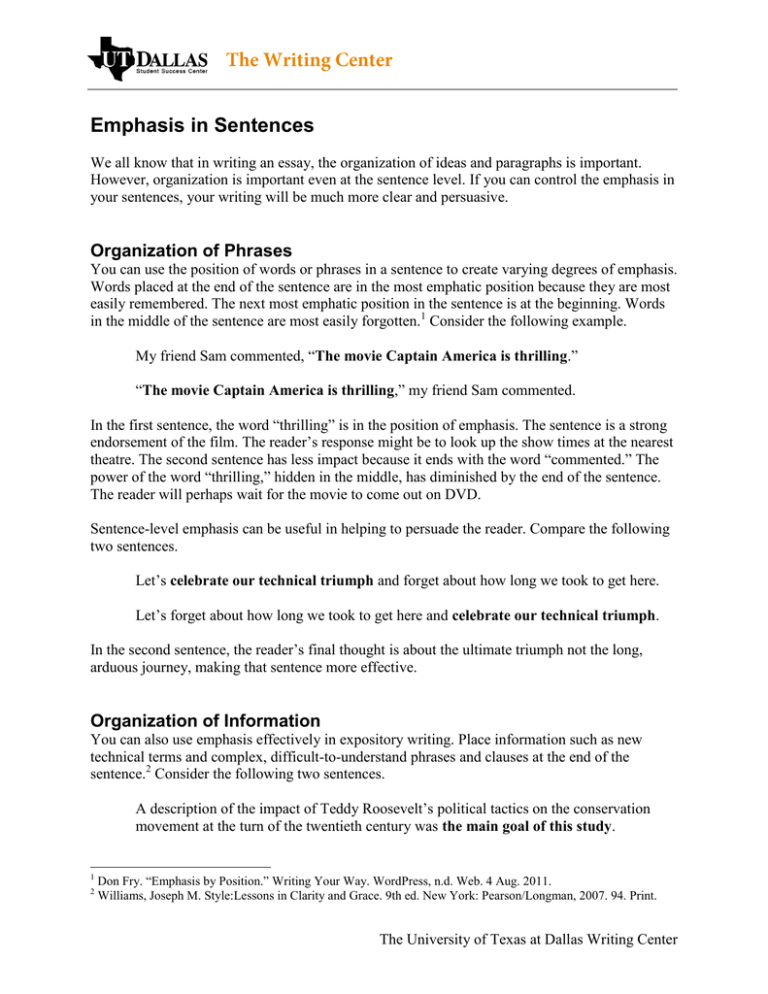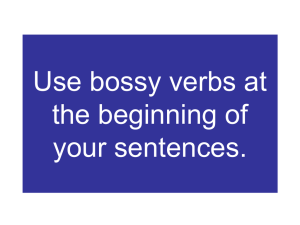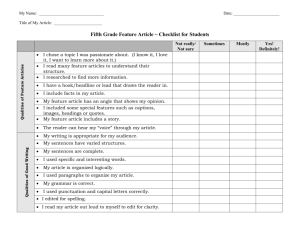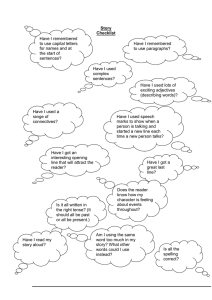
Emphasis in Sentences
We all know that in writing an essay, the organization of ideas and paragraphs is important.
However, organization is important even at the sentence level. If you can control the emphasis in
your sentences, your writing will be much more clear and persuasive.
Organization of Phrases
You can use the position of words or phrases in a sentence to create varying degrees of emphasis.
Words placed at the end of the sentence are in the most emphatic position because they are most
easily remembered. The next most emphatic position in the sentence is at the beginning. Words
in the middle of the sentence are most easily forgotten.1 Consider the following example.
My friend Sam commented, “The movie Captain America is thrilling.”
“The movie Captain America is thrilling,” my friend Sam commented.
In the first sentence, the word “thrilling” is in the position of emphasis. The sentence is a strong
endorsement of the film. The reader’s response might be to look up the show times at the nearest
theatre. The second sentence has less impact because it ends with the word “commented.” The
power of the word “thrilling,” hidden in the middle, has diminished by the end of the sentence.
The reader will perhaps wait for the movie to come out on DVD.
Sentence-level emphasis can be useful in helping to persuade the reader. Compare the following
two sentences.
Let’s celebrate our technical triumph and forget about how long we took to get here.
Let’s forget about how long we took to get here and celebrate our technical triumph.
In the second sentence, the reader’s final thought is about the ultimate triumph not the long,
arduous journey, making that sentence more effective.
Organization of Information
You can also use emphasis effectively in expository writing. Place information such as new
technical terms and complex, difficult-to-understand phrases and clauses at the end of the
sentence.2 Consider the following two sentences.
A description of the impact of Teddy Roosevelt’s political tactics on the conservation
movement at the turn of the twentieth century was the main goal of this study.
1
2
Don Fry. “Emphasis by Position.” Writing Your Way. WordPress, n.d. Web. 4 Aug. 2011.
Williams, Joseph M. Style:Lessons in Clarity and Grace. 9th ed. New York: Pearson/Longman, 2007. 94. Print.
The University of Texas at Dallas Writing Center
The main goal of this study was to describe the impact of Teddy Roosevelt’s political
tactics on the conservation movement at the turn of the twentieth century.
The first sentence is more difficult to read because of the long, complex opening. In the second
sentence, the introductory phrase tells the reader the significance of the information which
follows. The reader can then focus on and more easily remember the information itself.
In scientific and technical writing, placing the most complicated information at the end of the
sentence improves readability. Compare the following two sentences.
An increase in glucose intolerance in people over sixty-five as well as people with a
high body mass index is a common assumption in diabetes research.
A common assumption in diabetes research is that glucose intolerance increases in
people over sixty-five as well as in people with a high body mass index.
In the second sentence, the information itself is in the position of emphasis, making it more
memorable. Consequently, keeping in mind sentence-level emphasis is extremely useful in
technical and instructional writing.
Key Points and Guidelines
The end of the sentence is the most emphatic position.
The beginning of the sentence is the next most emphatic position.
Place the most persuasive part of a sentence at the end of the sentence.
Start a sentence with old information, and end it with new information.
Begin a sentence with simple information, and end it with complex information.
Contact
Want some help figuring out emphasis in your writing? Come talk to a tutor at the Writing
Center! Drop by or use the information below to contact us and set up an appointment.
(972) 883-6736
McDermott Library 1.206
http://www.utdallas.edu/studentsuccess/writing/
www.facebook.com/UTDallasWritingCenter
Tell us how we did on this handout and help us make all our handouts better! Respond to our
survey at www.tinyurl.com/handoutsurvey.
The University of Texas at Dallas Writing Center



